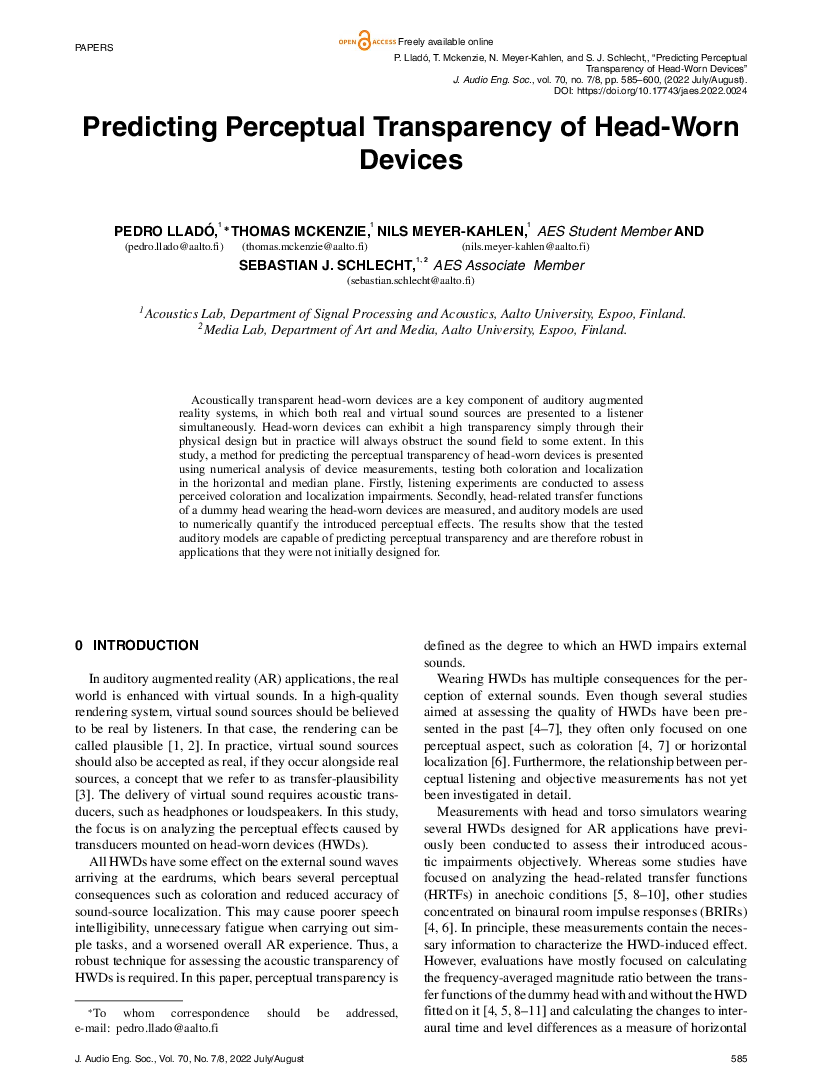Home / Publications / E-library page
You are currently logged in as an
Institutional Subscriber.
If you would like to logout,
please click on the button below.
Home / Publications / E-library page
Only AES members and Institutional Journal Subscribers can download
Acoustically transparent head-worn devices are a key component of auditory augmented reality systems, in which both real and virtual sound sources are presented to a listener simultaneously. Head-worn devices can exhibit high transparency simply through their physical design but in practice will always obstruct the sound field to some extent. In this study, a method for predicting the perceptual transparency of head-worn devices is presented using numerical analysis of device measurements, testing both coloration and localization in the horizontal and median plane. Firstly, listening experiments are conducted to assess perceived coloration and localization impairments. Secondly, head-related transfer functions of a dummy head wearing the head-worn devices are measured, and auditory models are used to numerically quantify the introduced perceptual effects. The results show that the tested auditory models are capable of predicting perceptual transparency and are therefore robust in applications that they were not initially designed for.
Author (s): Lladó, Pedro; Mckenzie, Thomas; Meyer-Kahlen, Nils; Schlecht, Sebastian J.
Affiliation:
Acoustics Lab, Department of Signal Processing and Acoustics, Aalto University, Espoo, Finland.; Acoustics Lab, Department of Signal Processing and Acoustics, Aalto University, Espoo, Finland.; Acoustics Lab, Department of Signal Processing and Acoustics, Aalto University, Espoo, Finland.; Acoustics Lab, Department of Signal Processing and Acoustics, Aalto University, Espoo, Finland.; Media Lab, Department of Art and Media, Aalto University, Espoo, Finland.
(See document for exact affiliation information.)
Publication Date:
2022-07-06
Import into BibTeX
Permalink: https://aes2.org/publications/elibrary-page/?id=21825
(1062KB)
Click to purchase paper as a non-member or login as an AES member. If your company or school subscribes to the E-Library then switch to the institutional version. If you are not an AES member Join the AES. If you need to check your member status, login to the Member Portal.

Lladó, Pedro; Mckenzie, Thomas; Meyer-Kahlen, Nils; Schlecht, Sebastian J.; 2022; Predicting Perceptual Transparency of Head-Worn Devices [PDF]; Acoustics Lab, Department of Signal Processing and Acoustics, Aalto University, Espoo, Finland.; Acoustics Lab, Department of Signal Processing and Acoustics, Aalto University, Espoo, Finland.; Acoustics Lab, Department of Signal Processing and Acoustics, Aalto University, Espoo, Finland.; Acoustics Lab, Department of Signal Processing and Acoustics, Aalto University, Espoo, Finland.; Media Lab, Department of Art and Media, Aalto University, Espoo, Finland.; Paper ; Available from: https://aes2.org/publications/elibrary-page/?id=21825
Lladó, Pedro; Mckenzie, Thomas; Meyer-Kahlen, Nils; Schlecht, Sebastian J.; Predicting Perceptual Transparency of Head-Worn Devices [PDF]; Acoustics Lab, Department of Signal Processing and Acoustics, Aalto University, Espoo, Finland.; Acoustics Lab, Department of Signal Processing and Acoustics, Aalto University, Espoo, Finland.; Acoustics Lab, Department of Signal Processing and Acoustics, Aalto University, Espoo, Finland.; Acoustics Lab, Department of Signal Processing and Acoustics, Aalto University, Espoo, Finland.; Media Lab, Department of Art and Media, Aalto University, Espoo, Finland.; Paper ; 2022 Available: https://aes2.org/publications/elibrary-page/?id=21825
@article{lladó2022predicting,
author={lladó pedro and mckenzie thomas and meyer-kahlen nils and schlecht sebastian j.},
journal={journal of the audio engineering society},
title={predicting perceptual transparency of head-worn devices},
year={2022},
volume={70},
issue={7/8},
pages={585-600},
month={july},}